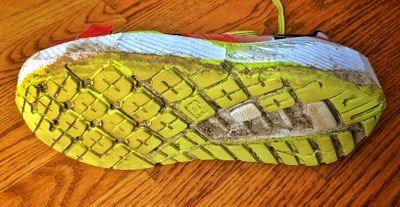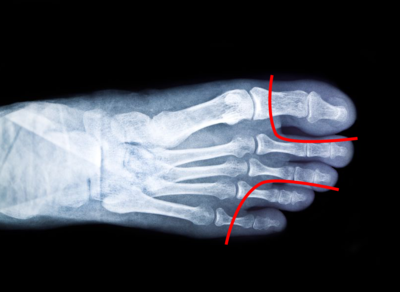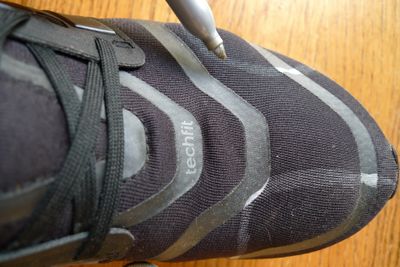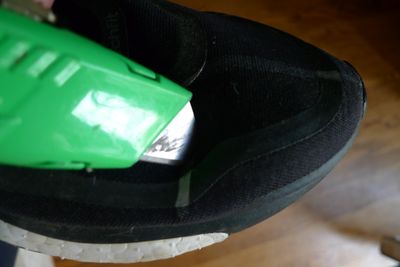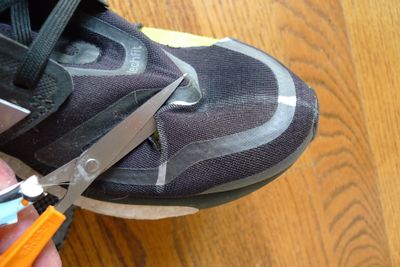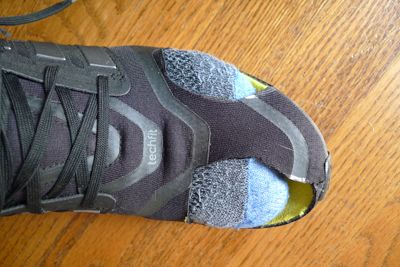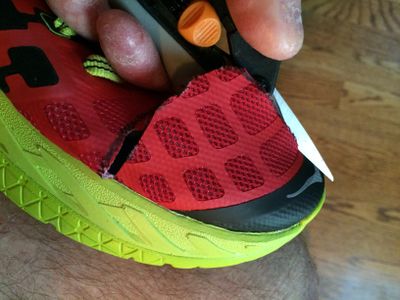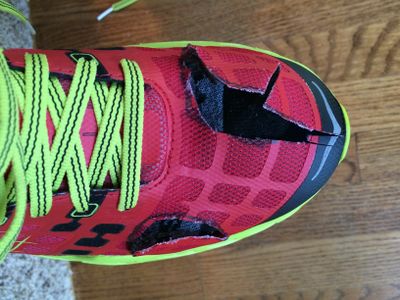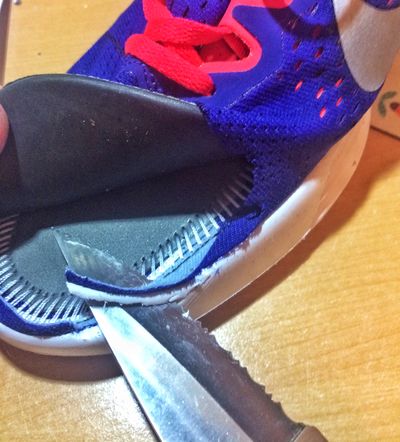Difference between revisions of "Shoe Modifications"
User:Fellrnr (User talk:Fellrnr | contribs) |
User:Fellrnr (User talk:Fellrnr | contribs) |
||
| Line 16: | Line 16: | ||
|- valign="top" | |- valign="top" | ||
|[[File:AltShoeMod1.jpg|none|thumb|400px| Here you can see the results of this partial "shoe-ectomy". This approach doesn't give quite the same level of freedom as completely removing the flap, but it does have some other advantages. You're less likely to get debris in your shoe when walking, as the flap partly covers the opening (it doesn't help much when slogging your way through long grass or undergrowth.) The flap also tends to keep your toes a tiny bit warmer, which is good in winter, but bad in summer. The main benefit is that you're less likely to get rubbing from the edge of the midsole, which can occasionally be an issue.]] | |[[File:AltShoeMod1.jpg|none|thumb|400px| Here you can see the results of this partial "shoe-ectomy". This approach doesn't give quite the same level of freedom as completely removing the flap, but it does have some other advantages. You're less likely to get debris in your shoe when walking, as the flap partly covers the opening (it doesn't help much when slogging your way through long grass or undergrowth.) The flap also tends to keep your toes a tiny bit warmer, which is good in winter, but bad in summer. The main benefit is that you're less likely to get rubbing from the edge of the midsole, which can occasionally be an issue.]] | ||
| + | |- valign="top" | ||
| + | |[[File:LunaRacerLip.jpg|none|thumb|400px|Sometimes the edge of the shoe can have a lip that holds the insole in place. This can cause discomfort and blisters, so you may need to remove the lip. Be careful not to cut any of the stitching that holds the shoe together. You can see the stitching fairly clearly on this picture. ]] | ||
|} | |} | ||
=Downsides= | =Downsides= | ||
| Line 22: | Line 24: | ||
* It's rather disconcerting to cut open shoes you've just paid a lot of money for. | * It's rather disconcerting to cut open shoes you've just paid a lot of money for. | ||
* The shoes can rip open because of the extra stress of the cuts. However, in the thousands of miles I've been running in shoes cut open, I've only had two pairs tear and then only after a lot of miles. | * The shoes can rip open because of the extra stress of the cuts. However, in the thousands of miles I've been running in shoes cut open, I've only had two pairs tear and then only after a lot of miles. | ||
| − | * You can get debris into the shoe. I've only found this to be an issue when walking, not running unless I'm running through long grass. | + | * You can get debris into the shoe. I've only found this to be an issue when walking, not running unless I'm running through long grass. |
| + | =The De-Snowshoe Modification= | ||
| + | There is a tendency for [[Maximalist]] shoes to not only have a thicker sole, but to also extend the sole outwards. This means the contact patch of the shoe is much wider than your foot, almost like a snowshoe. This extension can create torsional (twisting) forces on your ankle if your foot lands on the edge first. I've found it's worth trimming away this excess, as shown in the image below. | ||
| + | [[File:Clayton200 Snowshoe.jpg|none|thumb|400px|The [[Hoka Clayton]] with the sides of the sole trimmed to remove the "snowshoe".]] | ||
Revision as of 16:42, 7 November 2016

I cut open the toe box of nearly every shoe I run in to prevent blisters and to improve comfort. I started doing this to prevent blisters on ultramarathons, but over time I found that an open toe box allows my feet to move more naturally. When you run, your toes will tend to splay out at toe off, something that is inhibited by most running shoes. Of course, most people are reluctant to take a knife to their expensive running shoes, so I recommend trying get on an older pair of shoes that are close to the end of their life. This allows you to experiment with relatively little consequence. While cutting open the toe box can dramatically improve your comfort, there are limits to what it can do. If the toe box is too small, then your feet will hang over the edge of the midsole. A common concern with cutting open the toe box is getting depraved into your shoe. My experience is that this is only a problem when walking, or running through undergrowth. It's extremely rare for me to get something in my shoes while running.
1 Downsides
There are some downsides to cutting open the toe box.
- You can't return shoes you've cut open. In fact, you can't really even give them away!
- It's rather disconcerting to cut open shoes you've just paid a lot of money for.
- The shoes can rip open because of the extra stress of the cuts. However, in the thousands of miles I've been running in shoes cut open, I've only had two pairs tear and then only after a lot of miles.
- You can get debris into the shoe. I've only found this to be an issue when walking, not running unless I'm running through long grass.
2 The De-Snowshoe Modification
There is a tendency for Maximalist shoes to not only have a thicker sole, but to also extend the sole outwards. This means the contact patch of the shoe is much wider than your foot, almost like a snowshoe. This extension can create torsional (twisting) forces on your ankle if your foot lands on the edge first. I've found it's worth trimming away this excess, as shown in the image below.
